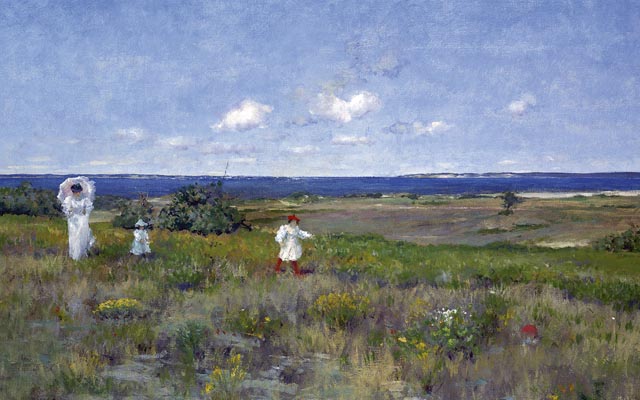Exhibition review: The American Impressionists
Averil King is delighted with a new exhibition which sheds new light on the works of American impressionists


With its detailed exploration of the impact of French Impres-sionism on American artists, this exhibition breaks new ground. It had fallen to two early-19th-century Lancashire-born landscapists, Thomas Cole and Thomas Moran, to first immortalise North America’s Catskill and Rocky Mountains, but a few decades later, European paintings, and especially those by French masters, were being avidly collected by wealthy Americans and exhibited in Boston and New York by the canny Durand-Ruel. The American artist William Merritt Chase was moved to declare: ‘MyGod, I would rather go to Europe than go to Heaven.’
From the early 1880s, with an awareness, if not an informed knowledge, of Impressionism percolating across the Atlantic, many Americans went to learn the painterly ropes in Europe, principally in France. Those who benefited most were French speakers, including the Pennsylvanian Mary Cassatt, who arrived in Paris as early as 1866. Her work was admired by Degas, who became a close friend and invited her to exhibit with the Impressionists.
Like many women artists, Cassatt’s subjects were often children. In paintings such as Children Playing on the Beach, 1884, and Woman Sitting with a Child in her Arms, about 1890, she took account of the French man’s novel approach to composition, yet her sturdy, sunburnt toddlers and sleepy babies had an earthy quality absent from Renoir’s more saccharine renderings of young children.
By 1880 or so, Monet was regarded by Americans as the grand maître of Impressionism, with aspiring artists from various countries flocking to the village of Giverny. In general, Monet, hating the thought of his work being copied, avoided meeting them, but Sargent and the unassuming Theodore Robinson, who, importantly, both spoke French, succeeded in penetrating his guard.
Monet seems to have admired Sargent, who was born in Florence of American parents, for the brilliance of his brushwork, and to have adopted a genial and fatherly attitude towards Robinson. Although the latter learned much from him and produced some competent landscapes—for instance, his From the Hill, Giverny the refinement of his technique could not be said to have approached that of his mentor.
An acolyte of Sargent himself, whom he met in 1887, the New Yorker Dennis Miller Bunker painted with him in the English countryside in the summer of 1888. Shown here are two attractive works he created in rural Massachusetts the following year, Roadside Cottage and The Pool, Medfield. Displaying a concern for the quality of light and, in the latter, brushwork made up of short, fragmented strokes, they clearly reflect his awareness of painterly developments in France.
Chase, well known as an artist and a teacher, was particularly influential in the development of American Impressionism. Returning to the USA in 1878 after studies in Munich, he made it his business to remain open-minded about the new movements in Europe. In 1891, he established a summer school for young artists in Long Island, where, like the Impressionists, his students could concentrate on working en plein air.
Sign up for the Country Life Newsletter
Exquisite houses, the beauty of Nature, and how to get the most from your life, straight to your inbox.
Advocating the use of bright colours and quick, impressionistic strokes of paint, Chase’s own work had a sparkling, vigorous character. The exhibition inc-ludes several of these appealing outdoor scenes, including Near the Beach, Shinnecock, 1895, and Morning at Breakwater, Shinnecock, about 1897.
One of the pleasures of this show is the light it sheds on artists little known outside America, including, for example, John Henry Twachtman. Following studies in Munich and Paris, he returned to rural Connecticut, producing calm, mesmeric scenes in which he used swathes of paint to create an almost mystical effect, as in his Sailing in the Mist. In The White Bridge, also painted in the 1890s, his take on the old bridge over a local river brings to mind Monet’s famous bridge at Giverny.
Although Twachtman’s style was unusual, even haunting, his career typified that of his compatriots, for, whatever their particular mode of working, they nearly all produced their most attractive work not in Europe, but when they were back in their native land.
Running between the exhib-ition rooms is a panel showing photographs of the Americans whose work is on display, together with brief descriptions of their lives and achievements. Complementing the intriguing array of paintings hung here, this helps us appreciate the significance of these transcontinental influences.
‘American Impressionism: A New Vision’ is at the Scottish National Gallery of Modern Art, Edinburgh, until October 19 (0131–624 6200; www.natonalgalleries.org).
The exhibition is accompanied by a fully illustrated catalogue (Yale University Press, £20)
This article was first published in Country Life on August 6 2014

